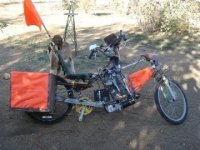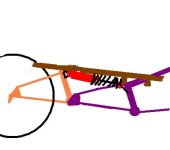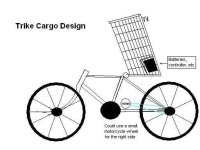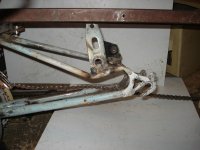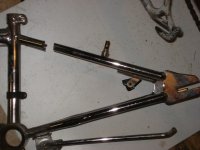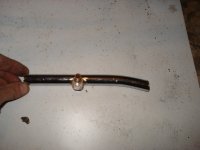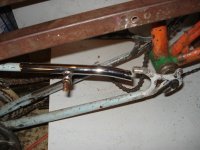This adds about a foot to the length of the bike, and about 15 pounds (so much for making it lighter) but it appears to be going ok so far.
Original:
View attachment 5
New:
View attachment 4
I've got several options for doing this, and this is just the first attempt, doing it the "easy way", that lets me revert back to the original at any point, without cutting into the original rear triangle. There are certainly better ways of doing it, but because of the cargo pods, they all require severe modification of the whole rear end that would preclude going back if it doesn't work out.
*This* method allows me to even undo it when I'm on the road, if something breaks unfixably on a longer test trip, though that would be pretty annoying and take at least an hour to do.
It starts with the 24" rear triangle originally slated for the unfinished ReCycle, and bolts it's crankshaft/BB to the dropouts of the CrazyBike2's rear triangle, in place of the wheel. The wheel now goes into the new triangle.
View attachment 3
Then a shock with coil-over spring, origin unknown but possibly motorcross bike, bolts to the top of the new rear triangle, pointing forward to align with the top of the original rear triangle/toptube to keep all the pushing forces along a strong line.
View attachment 6
The front mounting point for the shock is adjustable, to give me about two inches of adjust range, for altering rear end height when loaded if it is necessary. I did this by cutting a strong hard steel plate off the bottom of a heavy desk chair to weld to the square-tubing that supports the cargo pods and seat, as that is the strongest point on this section of the bike.
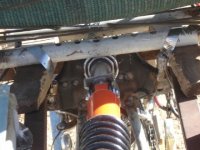
I bored a hole in it large enough for the steering tube from a discarded Razor kick scooter to fit thru, with the "fork" end pointing rearwards. I threaded the top nut for the tube on it's "rear" end, behind the plate, and the locknut on the "front" end in front of the plate. Those are what let me adjust it's length, and secure it to the bike.

The fork bolts thru the front pivot of the shock. The rear pivot bolts to two more small pieces of plate welded to the rear triangle just in front of the seat stays.
The preloading will be done by a tub-balancing-support cable off an old washing machine which will restrict how far the bike can pop back up after I get off of it, which will normally be sagging loose during the ride, so it will only ever have a load on it when it's not being ridden. It's main purpose is to keep the chain from ever having to rub on the frame, and so I can see what the bike is like when I am not on it, plus not having to climb up so high onto the seat.
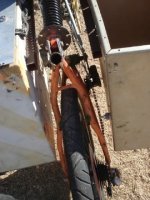
The spring compresses about 2/3 of it's length with me on it, leaving a bit for bumps and whatnot. If I have much cargo in the pods, it will compress most of the rest of the way, unfortunately, requiring a different leverage method for the spring to use it properly. I'm mostly doing it this way now so I can easily undo it, and because this method is easy to build and test.
Now, chainlines I'm still working out, so stuff may change as I do this. In theory with the spring preloaded by cable, the chain should pass normally thru both triangles to the rear wheel. That might not work perfectly thru the gear range at the back, so I might need to add a guide wheel to get around the stays. Hope not, but....
There is also a second derailer used only for it's tensioner, at the original dropouts. It's there solely to take up the slack as the triangle moves back down, and provide enough extra chain that I don't need to worry about the actual rear derailer jamming due to chain overtension when I'm on big ring front plus big ring rear on the occasions that must happen.


